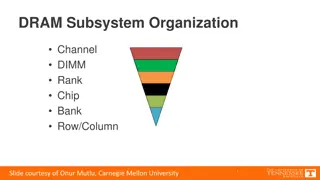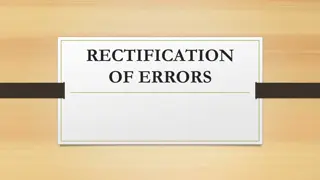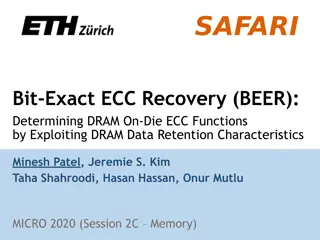Federal Employees Retirement System Errors Overview
Federal Employees Retirement System (FERS) encompasses various retirement plans with different contribution rates for federal employees. Recent discoveries of coding errors have led to a department-wide review to identify and rectify potential errors affecting thousands of employees. The errors rang
0 views • 14 slides
Understanding Errors in Quality Control Training
Explore the difference between systematic and random errors in labs, focusing on accuracy and precision. Learn about types of systematic errors such as shifts and trends, their causes, and how they affect the reliability of test systems. Discover the impact of random errors on precision and variabil
2 views • 13 slides
QuickBooks Errors Support
Navigating QuickBooks errors can be daunting, but with our expert support, you can conquer any challenge. Our comprehensive guide offers step-by-step solutions to resolve common QuickBooks errors efficiently, ensuring uninterrupted access to your financial data. Whether you're facing unrecoverable e
2 views • 3 slides
Understanding the Organization of DRAM Subsystem Components
Explore the intricate structure of the DRAM subsystem, including memory channels, DIMMs, ranks, chips, banks, and rows/columns. Delve into the breakdown of DIMMs, ranks, chips, and banks to comprehend the design and functioning of DRAM memory systems. Gain insights into address decoding, row/column
0 views • 16 slides
Understanding Errors in Pharmaceutical Analysis
This article explores different types of errors in pharmaceutical analysis, such as determinate and indeterminate errors, and discusses their impact on analysis results. It also covers the concepts of accuracy, precision, and minimizing systematic errors in analytical chemistry. The importance of id
1 views • 37 slides
Computer Architecture: Understanding SRAM and DRAM Memory Technologies
In the field of computer architecture, SRAM and DRAM are two prevalent memory technologies with distinct characteristics. SRAM retains data as long as power is present, while DRAM is dynamic and requires data refreshing. SRAM is built with high-speed CMOS technology, whereas DRAM is more dense and b
3 views • 38 slides
Understanding Exceptions in Computer Science
Errors in programming, such as syntax, semantic, runtime, and logical errors, can disrupt the execution of a program. Syntax errors relate to grammatical violations, semantic errors occur when statements lack meaning, and runtime errors happen during program execution due to illegal operations. By i
1 views • 35 slides
Understanding Rectification of Errors in Accounting
Preparation of trial balance is essential for verifying the accuracy of accounting records, but it is not a conclusive proof of correctness. Rectification of errors is crucial for ensuring the true and fair presentation of a business's financial position. Types of errors include errors of omission,
0 views • 14 slides
High-Throughput True Random Number Generation Using QUAC-TRNG
DRAM-based QUAC-TRNG provides high-throughput and low-latency true random number generation by utilizing commodity DRAM devices. By employing Quadruple Row Activation (QUAC), this method outperforms existing TRNGs, achieving a 15.08x improvement in throughput and passing all 15 NIST randomness tests
0 views • 10 slides
SIMDRAM: An End-to-End Framework for Bit-Serial SIMD Processing Using DRAM
SIMDRAM introduces a novel framework for efficient computation in DRAM, aiming to overcome data movement bottlenecks. It emphasizes Processing-in-Memory (PIM) and Processing-using-Memory (PuM) paradigms to enhance processing capabilities within DRAM while minimizing architectural changes. The motiva
2 views • 14 slides
Understanding Numerical Methods and Errors in Computation
Delve into the world of numerical methods through the guidance of Dr. M. Mohamed Surputheen. Explore topics such as solving algebraic and transcendental equations, simultaneous linear algebraic equations, interpolation, numerical integration, and solving ordinary differential equations. Learn about
0 views • 130 slides
Understanding Medication Errors in Healthcare
Medication errors are preventable mistakes in medication use that can lead to patient harm. Factors contributing to these errors include human-related, system-related, and medication-related issues. Human-related factors involve providers and patients being overworked, under-trained, or distracted,
0 views • 13 slides
Understanding and Rectifying Accounting Errors
Preparation of a trial balance helps in checking the accuracy of recording and posting transactions, but it may not always guarantee error-free records. Rectification of errors is essential to present a true financial picture. Types of errors include omission, commission, principle, and compensating
0 views • 14 slides
Insights into DRAM Power Consumption and Design Concerns
Detailed experimental study reveals that DRAM power models may not provide accurate insights into power consumption. The increasing importance of managing DRAM power in system design is emphasized. The study delves into DRAM organization, operation, and power consumption patterns, highlighting the n
0 views • 43 slides
Dram Shop Act and Premises Liability for Bar and Tavern Owners
Understanding the liabilities and responsibilities of bar and tavern owners under the Dram Shop Act based on the case of Build It and They Will Drink, Inc. v. Strauch. The act outlines exceptions where licensees can be held civilly liable for selling alcohol to minors or visibly intoxicated individu
0 views • 12 slides
Understanding Debugging in Programming
Debugging is a crucial aspect of programming to identify and fix errors that can cause program failures, hangs, or unexpected results. There are different types of errors such as compile errors, runtime errors, and logic errors, each requiring a different approach to resolve. Learning about the mode
0 views • 20 slides
Improving GPGPU Performance with Cooperative Thread Array Scheduling Techniques
Limited DRAM bandwidth poses a critical bottleneck in GPU performance, necessitating a comprehensive scheduling policy to reduce cache miss rates, enhance DRAM bandwidth, and improve latency hiding for GPUs. The CTA-aware scheduling techniques presented address these challenges by optimizing resourc
0 views • 33 slides
Solving Misprints: A Problem of Undetected Errors
Two proof-readers are checking a manuscript but find different numbers of errors. When only the errors they both find are compared, it reveals a specific pattern. This challenge prompts an exploration of the likelihood of undetected errors and how to approach similar problems by setting specific int
2 views • 25 slides
Enhancing Multi-Node Systems with Coherent DRAM Caches
Exploring the integration of Coherent DRAM Caches in multi-node systems to improve memory performance. Discusses the benefits, challenges, and potential performance improvements compared to existing memory-side cache solutions.
0 views • 28 slides
Enhancing Memory Cache Efficiency with DRAM Compression Techniques
Explore the challenges faced by Moore's Law in relation to bandwidth limitations and the innovative solutions such as 3D-DRAM caches and compressed memory systems. Discover how compressing DRAM caches can improve bandwidth and capacity, leading to enhanced performance in memory-intensive application
0 views • 48 slides
Grammar Errors Correction Exercises for English Language Learners
Correcting grammatical errors is essential for students learning English. This content provides exercises where students need to identify and correct errors in given sentences. The errors include punctuation mistakes, subject-verb agreement, possessive forms, and spelling errors. By practicing these
0 views • 23 slides
Architecting DRAM Caches for Low Latency and High Bandwidth
Addressing fundamental latency trade-offs in designing DRAM caches involves considerations such as memory stacking for improved latency and bandwidth, organizing large caches at cache-line granularity to minimize wasted space, and optimizing cache designs to reduce access latency. Challenges include
0 views • 32 slides
Understanding RowPress: A New Read Disturbance Phenomenon in Modern DRAM Chips
Demonstrating and analyzing RowPress, a novel read disturbance phenomenon causing bitflips in DRAM chips. Different from RowHammer vulnerability, RowPress showcases effective solutions on real Intel systems with DRAM chips.
0 views • 46 slides
Managing DRAM Latency Divergence in Irregular GPGPU Applications
Addressing memory latency challenges in irregular GPGPU applications, this study explores techniques like warp-aware memory scheduling and GPU memory controller optimization to reduce DRAM latency divergence. The research delves into the impact of SIMD lanes, coalescers, and warp-aware scheduling on
0 views • 33 slides
Panopticon: Complete In-DRAM Rowhammer Mitigation
Despite extensive research, DRAM remains vulnerable to Rowhammer attacks. The Panopticon project proposes a novel in-DRAM mitigation technique using counter mats within DRAM devices. This approach does not require costly changes at multiple layers and leverages existing DRAM logic for efficient miti
0 views • 17 slides
Understanding DRAM Errors: Implications for System Design
Exploring the nature of DRAM errors, this study delves into the causes, types, and implications for system design. From soft errors caused by cosmic rays to hard errors due to permanent hardware issues, the research examines error protection mechanisms and open questions surrounding DRAM errors. Pre
0 views • 31 slides
Transparent Hardware Management of Stacked DRAM for Memory Systems
Explore the innovative use of stacked DRAM as Part of Memory (PoM) to increase overall memory capacity and eliminate duplication. The system involves OS-managed PoM, challenges, and the potential of hardware-managed PoM to reduce OS-related overhead. Learn about the practical implications and evalua
0 views • 24 slides
Challenges and Solutions in Memory Hierarchies for System Performance Growth
The evolution of memory scaling poses challenges for system performance growth due to limitations in memory hierarchy, capacity gaps, and DRAM scaling obstacles. The need for alternative technologies and architectural support to address these challenges is highlighted, focusing on reducing latency,
0 views • 23 slides
Understanding Latency Variation in Modern DRAM Chips
This research delves into the complexities of latency variation in modern DRAM chips, highlighting factors such as imperfect manufacturing processes and high standard latencies chosen to boost yield. The study aims to characterize latency variation, optimize DRAM performance, and develop mechanisms
0 views • 37 slides
Understanding Power Consumption in Memory-Intensive Databases
This collection of research delves into the power challenges faced by memory-intensive databases (MMDBs) and explores strategies for reducing DRAM power draw. Topics covered include the impact of hardware features on power consumption, experimental setups for analyzing power breakdown, and the effec
0 views • 13 slides
A Software Memory Partition Approach for Eliminating Bank-level Interference in Multicore Systems
Memory requests from different threads can cause interferences in DRAM banks, impacting performance. The solution proposed involves partitioning DRAM banks between threads to eliminate interferences, leading to improved performance and energy savings.
0 views • 32 slides
Enhancing DRAM Performance with ChargeCache: A Novel Approach
Reduce average DRAM access latency by leveraging row access locality with ChargeCache, a cost-effective solution requiring no modifications to existing DRAM chips. By tracking recently accessed rows and adjusting timing parameters, ChargeCache achieves higher performance and lower DRAM energy consum
0 views • 33 slides
Intelligent DRAM Cache Strategies for Bandwidth Optimization
Efficiently managing DRAM caches is crucial due to increasing memory demands and bandwidth limitations. Strategies like using DRAM as a cache, architectural considerations for large DRAM caches, and understanding replacement policies are explored in this study to enhance memory bandwidth and capacit
0 views • 23 slides
Insights into Speech Production: Models, Errors, and Implications
Explore the intricacies of speech production through the lens of models, errors, and their impact on speech perception. Understand common types of errors in speech production, such as shifts, exchanges, anticipation, perseveration, additions, deletions, substitutions, and blends. Discover how errors
0 views • 38 slides
Enhancing Data Movement Efficiency in DRAM with Low-Cost Inter-Linked Subarrays (LISA)
This research focuses on improving bulk data movement efficiency within DRAM by introducing Low-Cost Inter-Linked Subarrays (LISA). By providing wide connectivity between subarrays, LISA enables fast inter-subarray data transfers, reducing latency and energy consumption. Key applications include fas
0 views • 49 slides
CLR-DRAM: Dynamic Capacity-Latency Trade-off Architecture
CLR-DRAM introduces a low-cost DRAM architecture that enables dynamic configuration for high capacity or low latency at the granularity of a row. By allowing a single DRAM row to switch between max-capacity and high-performance modes, it reduces key timing parameters, improves system performance, an
0 views • 42 slides
Exception Handling in Java: Understanding Errors and Exceptions
Exception handling in Java is crucial for dealing with errors and exceptions that can occur during program execution. Errors and exceptions are conditions that disrupt the normal flow of a program, and understanding their differences is key to effective error management. This chapter covers the conc
0 views • 32 slides
Locality-Aware Caching Policies for Hybrid Memories
Different memory technologies present unique strengths, and a hybrid memory system combining DRAM and PCM aims to leverage the best of both worlds. This research explores the challenge of data placement between these diverse memory devices, highlighting the use of row buffer locality as a key criter
0 views • 34 slides
Understanding Human Factors in Medical Errors
In a video discussing medical errors, it was highlighted that 100,000 to 200,000 people die annually due to medical errors in the USA. Causes were attributed to system failures, not just healthcare provider errors. Examples included a surgeon removing a healthy kidney instead of a diseased one and a
0 views • 13 slides
Understanding the Impact of On-Die ECC on DRAM Error Characteristics
The BEER project explores how on-die ECC complicates DRAM reliability studies by concealing error characteristics. It aims to uncover the unique ECC function of DRAM chips and infer error locations in error-prone cells. The study highlights the challenges in identifying and correcting bit flips obfu
0 views • 17 slides






































